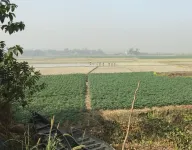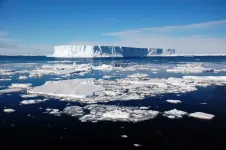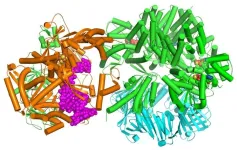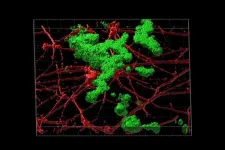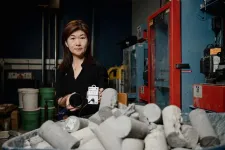(Press-News.org) When the question is “how are you feeling on the inside?,” it’s our vagus nerve that offers the answer.
But how does the body’s longest cranial nerve, running from brain to large intestine, encodes sensory information from the visceral organs? For his work investigating and mapping this internal information highway, Qiancheng Zhao is the 2024 grand prize winner of the Science & PINS Prize for Neuromodulation.
Interoception—the body’s ability to sense its internal state in a timely and precise manner—facilitated by the vagus plays a key role in respiratory, gastrointestinal, cardiovascular, endocrine and immune system functions.
Applying a variety of techniques, Zhao discovered that vagal sensory neurons independently code the three critical features of a body signal: the involved visceral organ, the tissue layer where the signal originates, and the type of sensory modality, as he writes in his award-winning essay in Science.
“We have generated a road map for the vagal interoceptive system—or maybe it is better to simply think of it as a delivery system like FedEx or UPS,” said Zhao, an assistant professor in medicine-endocrinology and McNair Scholar at Baylor University School of Medicine. “The vagus nerve is a bidirectional highway to communicate information between the body and the brain.”
His research could inform future therapies that stimulate the vagus nerve to treat a variety of physical and psychiatric disorders. At the moment, vagal nerve stimulation (VNS) through an implantable electrical pulse generator has been approved by the U.S. Food and Drug Administration to treat drug-resistant epilepsy and depression.
“Dr. Zhao’s essay is a very engaging journey in the world of bodily sensations. Dr. Zhao and colleagues developed a multi-pronged approach to determine how the vagal interoceptive system senses and responds to cues originating from different organs,” said Mattia Maroso, senior editor at Science. “Given the major clinical relevance that vagal nerve stimulation has gained in recent years, I predict that the results produced by Dr. Zhao and colleagues, beautifully presented in this year’s winner essay, will pave the way for better and more precise vagal nerve stimulation therapeutic interventions for interoceptive disorders.”
Complex cues
The vagal highway is crowded with traffic, with sensory and motor pathways intermingling in the nerve bundle. One of the potential challenges of expanding VNS is finding ways to identify and target specific vagal signals instead of broadly stimulating the nerve and potentially creating unwanted side effects.
“We know that vagal sensory neurons can project to the visceral organs,” said Zhao. “So our question was what signals from those visceral organs need to be sensed by vagal sensory neurons?”
To decipher the complexity of vagal sensory nerve traffic, Zhao and his colleagues focused on three aspects: the visceral organ sending the signal, the tissue layer in the organ where the signal originates and the kind of sensory stimulus.
Zhao combined a viral tracing approach with single-cell RNA sequencing to first identify organ-projecting neurons. The analysis revealed that vagal sensory neurons use differential gene modules to code specific visceral organs. In a second analysis, he traced neuronal projections in transparent, whole-mounted mouse organs to determine how vagal sensory neurons innervate the layers of specific tissues.
Finally, he and his colleague Chuyue Yu at Yale University developed a in vivo calcium imaging technique that allowed them to identify the molecular features of vagal sensory neurons responding to different types of stimuli, such as the mechanical inflation in the lung and the chemical stimuli of nutrients from a protein shake in the mouse GI tract.
“When we have the anatomical map together with the molecular information and the inputs from functional imaging, then we can really have a full picture to understand the sensory logic,” Zhao said.
All three coding modalities are independent, not arranged in a hierarchy. Since a relatively small number of vagal neurons must convey vast amounts of information, “this combinatorial strategy is a more efficient way to code diverse and numerous sensory cues from the body to the brain,” said Zhao.
Clinical applications
Zhao said his findings could provide potential new vagal targets, so future researchers might use these “genetic information to help them access different visceral organs precisely.”
The more detailed map also could help clarify the vagus nerve’s role in interoception and whether there might be neuralmodulatory applications for treating interoceptive disorders, he added.
Zhao is interested in discovering more about how vagal sensory neurons might behave differently across the lifespan and under different disease conditions. “We know that our physiological parameters, such as heart rate, blood pressure will change during aging so we might want to look, for example, at how the aging state changes the interaction between the sensory nerve and different organs.”
The Science & PINS Prize is awarded annually for innovative research that modulates neural activity through physical (electrical, magnetic, optical) stimulation of targeted sites in the nervous system with implications for translational medicine. The winner of the prize is awarded US$25,000 and publication of his or her essay in Science.
FINALIST
Ibrahim M. Salman is a 2024 finalist for his essay “Aortic baroreceptor afferents as targets for blood pressure control in hypertension.” Salman received his undergraduate degree in pharmaceutical sciences from the University of Baghdad and his Ph.D. in advanced medicine from Macquarie University. After completing his postdoctoral fellowship at Case Western Reserve University, he accepted an appointment as an assistant professor of pharmacology and physiology and neuromodulation scientist at Alfaisal University in 2019. Salman’s research integrates electrophysiology, whole fiber neural recordings and invasive neurostimulation to develop innovative, drug-free neuromodulation interventions with a translation potential for treating cardiovascular disorders.
END
Award-winning research maps the body’s internal sensory communication highway
Prize-winning work uncovers how vagal sensory neurons encode information
2024-08-01
ELSE PRESS RELEASES FROM THIS DATE:
Current Andean glacier loss is unprecedented in the Holocene
2024-08-01
Andean tropical glaciers are experiencing unprecedented retreat, according to a new study that reveals their current sizes are the smallest in over 11,700 years. “Our finding … identifies this region as a hot spot in our understanding of the changing state of the cryosphere,” say the authors. Glaciers act as important indicators of climate change, with their global retreat accelerating over recent decades. Examining this retreat in the context of the previous 11,700 years of the Holocene interglacial highlights the impact of modern global warming. Although many glaciers worldwide are smaller today compared to ...
New fossil resembling a bristly durian fruit reveals insights into the origin of molluscan skeletons
2024-08-01
The early evolution of mollusks has been hard to pin down, but now a newly discovered fossil – of a shell-less, soft-bodied, spiny mollusk from the early Cambrian – provides crucial insights, researchers report. The findings suggest that this fossil, of a creature called Shishania aculeata, is a stem mollusk – representative of an intermediate between early members of the superphylum lophotrochozoans and more derived mollusks. Mollusks are one of the most diverse groups of animals, encompassing various well-known forms such as clams, ...
CLEAR: a new approach to 3D printing materials with highly entangled polymer networks
2024-08-01
Researchers have developed a novel approach to three-dimensional (3D) printing they call “CLEAR,” which significantly improves the strength and durability of materials by using a combination of light and dark chemical reactions to create densely entangled polymer chains. The authors used their approach to print structures with special features, such as the ability to adhere to wet tissues. Incorporation of polymer chain entanglements as reinforcements within 3D printed materials can significantly enhance their mechanical properties. However, traditional vat photopolymerization-based 3D printing techniques, such as digital ...
Genetic insights into how prickles develop across different plants, despite evolutionary separation
2024-08-01
The evolutionary gain and loss of plant prickles – sharp pointed epidermal outgrowths – are controlled by a shared genetic program involving cytokinin biosynthesis, researchers report. The study sheds light on the genetic basis of the emergence of similar traits in distantly related organisms and reveals genomic targets for prickle removal for crop improvement. The genetic basis of trait convergence is a central question in evolutionary biology, and the extent to which it is driven by ...
Climate anomalies may play a major role in driving cholera pandemics
2024-08-01
New research suggests that an El Niño event may have aided the establishment and spread of a novel cholera strain during an early 20th-century pandemic, supporting the idea that climate anomalies could create opportunities for the emergence of new cholera strains. Xavier Rodo of Instituto de Salud Global de Barcelona, Spain, and colleagues present these findings in the open-access journal PLOS Neglected Tropical Diseases.
Since 1961, more than 1 million people worldwide have died in an ongoing cholera pandemic, the seventh cholera ...
Study shows link between asymmetric polar ice sheet evolution and global climate
2024-08-01
Recent joint research led by Professor AN Zhisheng from the Institute of Earth Environment of the Chinese Academy of Sciences has revealed the pivotal role of the growth of the Antarctic ice sheet and associated Southern Hemisphere sea ice expansion in triggering the mid-Pleistocene climate transition (MPT). It has also shown how asymmetric polar ice sheet evolution affects global climate.
The MPT refers to a shift in Earth’s climate system between about ~1.25–0.7 million years ago, marking a shift to more pronounced and regular ...
When it comes to DNA replication, humans and baker’s yeast are more alike than different
2024-08-01
GRAND RAPIDS, Mich. (Aug. 1, 2024) — Humans and baker’s yeast have more in common than meets the eye, including an important mechanism that helps ensure DNA is copied correctly, reports a pair of studies published in the journals Science and Proceedings of the National Academy of Sciences.
The findings visualize for the first time a molecular complex — called CTF18-RFC in humans and Ctf18-RFC in yeast — that loads a “clamp” onto DNA to keep parts of the replication machinery from falling off the DNA strand.
It is the latest discovery from longtime collaborators Huilin Li, Ph.D., of Van Andel Institute, ...
Aging-related genomic culprit found in Alzheimer’s disease
2024-08-01
Researchers at Washington University School of Medicine in St. Louis have developed a way to capture the effects of aging in the development of Alzheimer’s disease. They have devised a method to study aged neurons in the lab without a brain biopsy, an advancement that could contribute to a better understanding of the disease and new treatment strategies.
The scientists transformed skin cells taken from patients with late-onset Alzheimer’s disease into brain cells called neurons. Late-onset Alzheimer’s ...
Andean glaciers have retreated to lowest levels in 11,700 years, news study finds
2024-08-01
Chestnut Hill, Mass (8/1/2024) – Rocks recently exposed to the sky after being covered with prehistoric ice show that tropical glaciers have shrunk to their smallest size in more than 11,700 years, revealing the tropics have already warmed past limits last seen earlier in the Holocene age, researchers from Boston College report today in the journal Science.
Scientists have predicted glaciers would melt, or retreat, as temperatures warm in the tropics – those regions bordering the Earth’s ...
States consider new science-backed solution to save time and money on concrete infrastructure repair
2024-08-01
WEST LAFAYETTE, Ind. — A Purdue University invention that may shorten construction timelines and increase long-term durability of concrete highways, bridges and other transportation infrastructure is emerging as a viable alternative to methods that have been used for decades to estimate when newly poured concrete is mature enough to withstand heavy loads such as those from trucks and other vehicles.
The American Association of State Highway and Transportation Officials’ Committee on Materials and Pavements (AASHTO COMP) has approved the Purdue-developed method as a new national ...
LAST 30 PRESS RELEASES:
Ambitious model fails to explain near-death experiences, experts say
Multifaceted effects of inward foreign direct investment on new venture creation
Exploring mutations that spontaneously switch on a key brain cell receptor
Two-step genome editing enables the creation of full-length humanized mouse models
Pusan National University researchers develop light-activated tissue adhesive patch for rapid, watertight neurosurgical sealing
Study finds so-called super agers tend to have at least two key genetic advantages
Brain stimulation device cleared for ADHD in the US is overall safe but ineffective
Scientists discover natural ‘brake’ that could stop harmful inflammation
Tougher solid electrolyte advances long-sought lithium metal batteries
Experts provide policy roadmap to reduce dementia risk
New 3D imaging system could address limitations of MRI, CT and ultrasound
First-in-human drug trial lowers high blood fats
Decades of dredging are pushing the Dutch Western Scheldt Estuary beyond its ecological limits
A view into the innermost workings of life: First scanning electron microscope with nanomanipulator inaugurated in hesse at Goethe University
Simple method can enable early detection and prevention of chronic kidney disease
S-species-stimulated deep reconstruction of ultra-homogeneous CuS nanosheets for efficient HMF electrooxidation
Mechanical and corrosion behavior of additively manufactured NiTi shape memory alloys
New discovery rewrites the rules of antigen presentation
Researchers achieve chain-length control of fatty acid biosynthesis in yeast
Water interactions in molecular sieve catalysis: Framework evolution and reaction modulation
Shark biology breakthrough: Study tracks tiger sharks to Maui mating hub
Mysterious iron ‘bar’ discovered in famous nebula
World-first tool reduces harmful engagement with AI-generated explicit images
Learning about public consensus on climate change does little to boost people’s support for action, study shows
Sylvester Cancer Tip Sheet for January 2026
The Global Ocean Ship-Based Hydrographic Investigations Program (GO-SHIP) receives the Ocean Observing Team Award
Elva Escobar Briones selected for The Oceanography Society Mentoring Award
Why a life-threatening sedative is being prescribed more often for seniors
Findings suggest that certain medications for Type 2 diabetes reduce risk of dementia
UC Riverside scientists win 2025 Buchalter Cosmology Prize
[Press-News.org] Award-winning research maps the body’s internal sensory communication highwayPrize-winning work uncovers how vagal sensory neurons encode information
